Loren C. Steffy's Blog
October 11, 2023
Rethinking Frankenstein — again

I’ve read Mary Shelley’s Frankenstein several times, and on my bookshelf I have a copy lavishly illustrated by comic book artist Bernie Wrightson. The story has been told and retold and re-imagined. Indeed Mel Brooks’ Young Frankenstein is one of my favorite films.
But the Hollywood versions of the book tend to focus on “the monster” — bolts in the neck, bad haircut, arms extended, clumping along as if sleepwalking.
The book, however, is more complex and nuanced. It can be read many different ways. It is, on its surface, a great monster tale. It’s a book that is often credited with launching science fiction as a genre. Its subtitle, “The Modern Prometheus,” implies a morality tale in which Frankenstein’s creation is an affront to God, or that Frankenstein himself has defied God by creating life through unnatural means.
Now, as Ruth Franklin writes in The New Yorker, a new novel by Dutch writer Anne Eekhout, Mary and the Birth of Frankenstein, poses the idea that the novel may have resulted from Shelley’s relationship with another woman. Indeed, in the original book, female characters are minor. But Victor himself could have been a proxy for Shelley, and his loathing and fear of “the fiend” his struggle to come to terms with homosexuality and the social stigma associated with it at time.
While Hollywood has made Frankenstein’s name synonymous with the monster, in the book, Victor Frankenstein refers to his creation in vaguer terms — “the being,” “the fiend.” The ambitiousness of the horror has allowed numerous interpretations over the years. The origin of the story is well-known. Shelley began writing it at age 18, after the death of her first child, and her grief is thought to have inspired the original idea of bringing the dead back to life.
As Franklin writes:
The novel can be read as a fantasy of reproduction without women, giving rise to queer-oriented interpretations. Critics have noticed that the horror and revulsion with which Victor reacts to his creation, which is male, resemble the “homosexual panic” sometimes manifested by men confronted with homosexuality in nineteenth-century England, where sexual relations between men had been criminalized for at least five hundred years. The creature initially appears at Victor’s bedside as he awakens from a nightmare about kissing Elizabeth, his cousin and intended bride, who turns into a corpse in his arms. Victor, whose closest relationship is with his boyhood friend Henry Clerval, refers to his creation as a “dreadful secret” that he can reveal to Elizabeth only after their wedding night.
In the introduction to the Wrighson illustrated edition, Stephen King says he believes most modern readers find Frankenstein disappointing. There’s been too many movies and attempts to play up the horror. What’s lost is the subtler aspects of the book. King calls it “a wild tale” with “joyous, energetic, representations of life.”
Indeed, those representations are open to a wide range of interpretations, and that’s what makes Frankenstein so captivating. I haven’t read Eekhout’s book, but just hearing about it makes me want to re-read Shelley’s original.
August 2, 2023
Texas A&M and politicized threats to higher education

My alma mater has been in the news a lot lately, and not in a good way. A botched hiring of a longtime journalist and former student to lead the revived journalism program resulted in the resignation of the university’s president. Last week, I wrote an essay for Texas Monthly on everything that had happened and tried to put some context around it. That piece led to a discussion with Tom Fox for an episode of the Hill Country podcast, which aired today.
If you’re wondering how the controversy over the hiring of Kathleen McElroy began or why universities need to embrace inclusion (despite what our politicians may think) and create an environment where all student feel welcome, these are good places to start.
July 10, 2023
Indiana Jones dials up a new adventure, but it isn’t shipshape
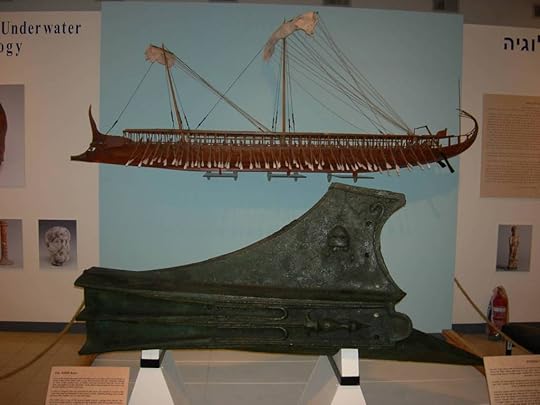 The Athlit Ram on display in Israel’s National Maritime Museum in Haifa
The Athlit Ram on display in Israel’s National Maritime Museum in HaifaIf you’re an Indiana Jones fan, you’re probably familiar with the plot structure for The Dial of Destiny, the latest installment in the film series. It follows the same pattern the previous films: Take a known archaeological artifact, give it mystical powers, and leave clues all over the world for Indy and his nemeses (usually Nazis) to pursue.
The Dial of Destiny focuses on the Antikthera Mechanism, a bronze device with interlocking gears that is believed to have predicted the movement of the sun, moon and planets. It may even have predicted solar and lunar eclipses.
The mechanism was discovered in the wreck of a Greek merchant ship found by sponge divers in 1900. But that’s where the movie veers from reality. The Antikthera Mechanism wasn’t split into two pieces and hidden, and neither of those pieces were collected by the Third Reich. It’s in the National Archaeological Museum in Athens. So far, it hasn’t opened any time portals.
The movie claims one part of the mechanism was found not on a Greek cargo ship, but a Roman warship. And here I have a few nits to pick, since I grew up with a father who was a leading authority on ancient ships and who frequently pointed out inaccuracies in films and television shows.
I don’t think my dad ever watched an entire Indiana Jones film, and he found the entire premise amusing. The closest my dad got to fighting Nazis was during his time on a destroyer escort in World War II.
But he would have taken issue with the claim that a Roman warship was found in 1900.
While Greek and Turkish sponge divers discovered dozens of shipwrecks in the Mediterranean, they didn’t find warships. Nautical archaeologists for years puzzled why most of the ancients ships they discovered were merchant vessels, even though written texts speak of hundreds of naval battles.
One theory was that without cargo to press their hulls into the seafloor, sunken warships simply rotted away. Wood exposed to warm water for centuries deteriorates quickly, and it’s a favorite of teredo worms, mollusks that borrow into exposed wood.
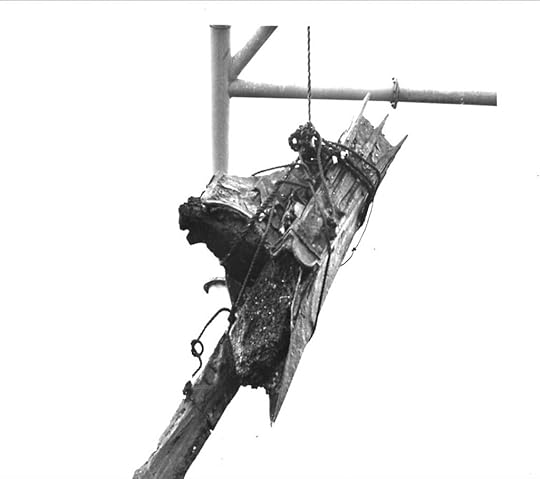 The ram being lifted from the water by a crane in 1981
The ram being lifted from the water by a crane in 1981In 1981, Israeli archaeologists recovered a battering ram from a Roman warship in the Sea of Athlit. The main hull was long gone, but my father oversaw the removal of the 16 pieces of wood inside the ram’s bronze casing. As I wrote in my book The Man Who Thought Like a Ship:
The ram’s design was simply brilliant. Its blunted end ensured it would batter its enemy yet not ensnare its own vessel as a pointed, spear-like design would; its underlying wood structure [was designed for] dissipating the force of the impact along the hull, minimizing the damage to the ramming ship.
My other quibble with the movie is that the second half of the Antikthera device is unearthed in another wreck of a Roman warship (which was located way too easily). The wreck is remarkably intact. Again, a ship that sank in warm water in the 4th century BC would not have any hull timbers remaining above the sea floor.
It’s the reason that nautical archaeologists for years debated ship design of upper hulls. For example, no one knew the spacing of oars on Byzantine galleys until about 20 years ago because bulwarks and upper hull sections rarely survived underwater.
It mattered because if galleys allowed too much room for the oarsmen, the hull would sag in the middle under their weight. If the oars were too close together, oarsmen couldn’t get a full stroke, leaving the vessel underpowered. Replicas of a Greek trireme and other vessels were built to test out various theories, but without the discovery of an upper hull, no one knew for sure.
Then, in 2004, construction crews digging a subway tunnel in Istanbul’s Yenikapi neighborhood undercovered the ancient harbor of Theodosius, one of Constantinople’s trading ports. The site contained 37 medieval ships, and because they hadn’t been rotting on the seabed for centuries, the bulwarks were preserved, giving an accurate measurement of the oar spacing for a Byzantine galley (95 centimeters).
And finally, one other point about the movie worth mentioning: if you’re a diver, you know that Antonio Banderas’s tactic for avoiding the bends is not just wrong but dangerous.
Of course, if you’re willing to accept the idea that Indiana Jones and a group of Nazis flew back in time to the 4th century BC and witnessed the Battle of Syracuse, you probably aren’t too worried about whether the ships are depicted accurately.
And if they hadn’t had an intact shipwreck, they wouldn’t have had a place for the moray eels. What’s an Indiana Jones movie without a gross-out snake/bug/invested skeleton scene?
I enjoyed the film, and I’m a little surprised the film is already being a labeled a flop. Its financial failure may say more about the state of cinema today than the movie itself. The new film is an enjoyable addition to the series, even if it pales compared with the original.
May 23, 2023
Decimation and content
This post originally appeared on Stoney Creek Publishing’s Life in the Word Mines blog.

No robots allowed
Last fall, signing books at the Texas Book Festival, I sat next to Dick Reavis, long-time writer for the San Antonio Express-News and other publications. I asked him to sign a copy of Texas Reporter, Texas Radical, a collection of his writings compiled by Michael Demson and published last year by Texas Review Press.
He wrote: “For Loren, another of our decimated trade.”
He was referring to journalism, but the more I thought about his inscription, the more it seemed to apply to writing in general, and beyond that, all creative trades.
Some may be unfamiliar with the term “writing.” These days it’s often called “content” — a vacuous term, hollow, imprecise, empty. Writing fills the soul. Content simply fills the page.
And it is content — the relegation of writing to the role of filler — that has led to the decimation to which Reavis referred. All that’s left is a reductive, dismissive label. Content has no inherent value. It is simply the lure to draw your eyeballs to a site, perhaps get them to hover there for a moment in hopes that you might — oh, rapture! — click on something. With enough clicks, maybe someone may derive some value — but that someone probably won’t be the writer, or as they’re now known, the content creator.
Many journalists friends cling to the hope that the world will always need good journalism, and writer friends say there will always be a place for good writing. That’s true. But it is a place of diminishing value.
The internet has been a great democratizer, but it has also been a source of devaluation as it strives to make all creativity free. People are insulted if on social media you link to a news story that’s behind a paywall. With Kindle Unlimited, you can read any number of books a month for $10, (soon to be $12). They may not be the books you want, but content is all about volume. Streaming music services make songwriting available for little or no cost. Neflix, HBO Max, Hulu, and their ilk vomit forth a steady stream of shows — some great, some awful, it doesn’t matter — to lure subscribers. Podcasts proliferate faster than flies at a feedlot. Everyone’s ‘casting, (me included) but few are paid.
We wallow in a smorgasbord of “content,” served up from the remnants of our decimated trade.
Some people still buy print newspapers, vinyl records, and cinema tickets, but not enough to justify the cost of producing the “content.” I still do some freelance writing, but the value of my lance has declined to the point that it might as well be free.
As Disney’s quarterly earnings show (sorry, paywall), streaming companies are in a tug-of-war between growth and profit. In the world of content, more subscribers don’t mean more money. The cost of content outpaces the revenue from growth. There’s a reason Hollywood writers are on the picket lines — the economics of content always demand they write more for less.
And publishing? At the indie level at which Stoney Creek operates, every book is a struggle to keep costs from swamping revenue, driving by the belief that the books we publish do, indeed, have value for the people who still appreciate it.
With so many refugees amidst the flotsam of the decimated trade, someone else will always make content for less. And of course, no one will make it for less than the robots. Already, social media feeds are awash with come-ons telling me I shouldn’t bother writing something like this, a chatbot or robowriter could do it for me.
“Don’t waste your time writing social media posts,” they say. They aren’t questioning the value of social media, but in a way, they are. What happens when we value human connection so little that we don’t even care if humans are attempting the connection?
I welcome robots for menial tasks — checking my spelling, transcribing notes, even suggesting prompts for stories. But the actual writing? Sorry, that’s mine. For me, being in the moment, feeling the flow of ideas, finding the words that convey meaning — that is the place of joy. That’s the reason I do everything else.
My books, newspaper columns, and magazine articles often start with a pen and notebook, and written in a comfy chair or, on nice days, a little wooded area on our property — anywhere away from email notifications, text messages, social media alerts, and self-important software updates.
It’s not because I hate technology. In fact, I love it and covered the industry for years. But I know its place. And it is not welcome between me and my words, and between my words and whatever readers haven’t been lost to the robot-generated brain candy of the internet.
The trade has indeed been decimated. The value of what we do continues to decline, but we do it anyway. Let the robots answer the email and let them respond to content generated by their mechanical ilk. Because, really, we don’t write to grow an audience, reach readers, or make lots of money. Those are nice when they happen, but writers will always write. Decimation and robots be damned.
April 24, 2023
The Texas connection to Chile’s ‘observatory alley’
 A rendering of the completed Giant Magellan Telescope during daytime in Chile.
A rendering of the completed Giant Magellan Telescope during daytime in Chile.The New York Times recently wrote about Chile’s “observatory alley,” an 800-mile stretch of the Atacama desert, a plateau high in the Andes whose clear night skies have been attracting astronomers for half a century.
The story talks about some of the existing observatories in the region, and then mentions that its also the site for the Giant Magellan Telescope that will be more powerful than any existing ground-based telescope. The GMT, as its known, is being developed by the Carnegie Institution for Science and a consortium of 13 universities and institutions. As the story notes:
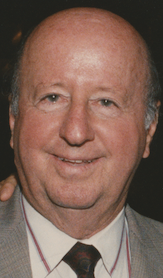
When completed, the telescope will have seven mirrors, each eight meters in diameter, that together will act as a 22-meter-diameter telescope, roughly 20 times as powerful as Palomar. The G.M.T. will be built at the top of Cerro Las Campanas, two miles from the domes of the Carnegie’s existing telescopes.
Two of those universities are the University of Texas and Texas A&M University, and their involvement, as well as key funding for the GMT was provided by Houston oilman, developer and philanthropist George Mitchell. Mitchell was a key supporter of the physics and astronomy programs at A&M, and put up the funding for the first GMT mirrors. Those mirrors were nicknamed George and Cynthia, in honor of Mitchell and his wife.
I devoted an entire chapter of my biography about Mitchell to his support for astronomy and the GMT. Although neither George nor Cynthia lived to see the completion of the project, their legacy will live on when the telescope achieve “first light” sometime before the end of the decade.
April 23, 2023
New blog digs into ‘life in the word mines’
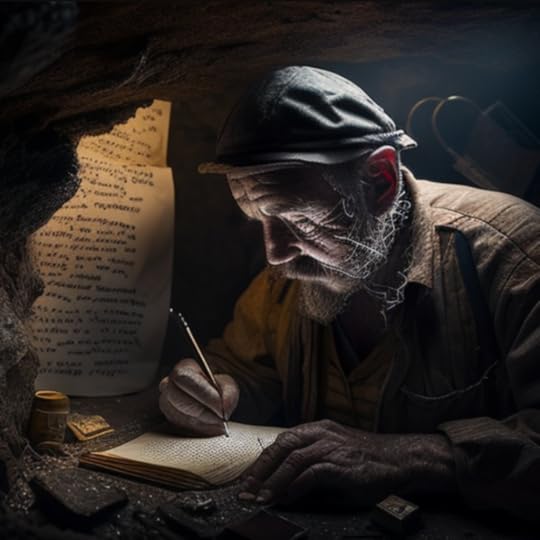
If you like some of the posts I’ve done here — admittedly rather sporadically — about writing and books, you might want to check out a new blog, Life in the Word Mines, at Stoney Creek Publishing. I’ll be contributing pieces about writing and publishing, and there will be interesting insights from others in the business about the process of writing, designing, publishing, and promoting books.
There will also be updates on author events, book signings, and new releases, as well as recommendations for books, podcasts, and articles about the craft of writing.
If you’re an aspiring or published writer or simply want to understand more about how publishing works (or doesn’t work), I hope you’ll join us and enter the mines.
Meanwhile, this blog will continue, as I weigh in other topics that I find interesting, such as energy, immigration, business, and economics, as well personal reflections.
January 11, 2023
Rediscovering a “lost” puffin story
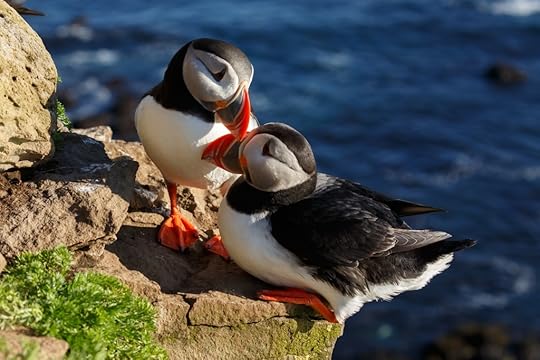
In mid-December, my wife and I had an unexpected discussion about puffins. She was scrolling through Netflix or Hulu, and there was a special about the sea birds, and I declared my fascination with them, even though I’ve never seen on in the wild.
She seemed surprised, and I explained it was because of a book my mother bought for me when I was seven. We were living in Cyprus, and we hadn’t brought many books with us from the States. The few she could find in English for kids my age were mostly nightmarish British fairy tales, which tended to end horribly for the children involved. (One was about a girl who finds magic dancing shoes that force her to dance herself to death. Not exactly the nice bedtime fare Mom had in mind.)
One day she came home with a new paperback — my first chapter book. I couldn’t quite read it myself, so she read it to me. And I was captivated by the puffins that featured prominently in the story. I couldn’t remember much else about the plot. As I recounted this to my wife, I couldn’t even recall the name of the book. I’d kept it for years but discarded it at some point as I got older.
I remembered it was about four kids who had an adventure with a family friend. They were supposed to be going on holiday, and they went to some bird-filled islands off the northern Scottish coast that were uninhabited by humans. Mostly I remembered it had details about how puffins nested (or burrowed), how they behaved, and how they were unafraid of humans.
I thought perhaps the book was called Puffin Island. The only other thing I remember was that it was written by a well-known British children’s author that one of my father’s British colleagues was familiar with.
I also vaguely remembered the cover — yellow with a boat. The more I described the book to my wife, the more determined I became to find it.
I searched on British YA authors and puffins but came up empty. I tried “best-known British YA authors.” Nothing. I narrowed the search to books from the late 1960s to early 1970s. Still nothing. Finally, I searched images instead of text, and there it was — The Sea of Adventure by Enid Blyton.
Looking at the cover, I saw the name of the boat on the stern. “That’s right!” I said. “The Lucky Star. And it gets smashed up somehow and one of the kids made a comment about how it wasn’t so lucky.”

My wife looked on, amused that I was spending so much time chasing down an obscure book from my childhood.
Originally written in 1948, I was able to order the 1969 edition, the same one I’d had in Cyprus. Blyton wrote more than 700 books that have been translated into more than 40 languages and sold more than 400 million copies, making her one of the most successful children’s authors of all time. The Sea of Adventure is part of a series of eight books involving the same four kids who get caught up in various forms of intrigue. Not only is The Sea of Adventure still in print, MacMillian is coming out with a new edition later this year.
There was even an Enid Blyton Adventure Series TV show in the 1990s that included an adaptation of The Sea of Adventure, though apparently penguins were substituted for puffins.
Over the holidays, I relived my childhood by re-reading the book. Sure enough, there was a lot about puffins. (My recollection of “Puffin Island” wasn’t too far off — it was the name the kids gave to one of the islands they visited.) Two of the birds — Huffin and Puffin — befriend the kids and follow them on their adventure. I had forgotten about the comedy-relief parrot, Kiki, and many other plot points.
Even as an adult, it’s an enjoyable book, and it was all the more delightful because of the memories it conjured of a special time in my childhood. As I turned the pages, those memories came flooding back — my mother and I, sitting on the couch, the Mediterranean breezes blowing in from the balcony, my mind awash in images of these strange seabirds.
I’m sure the islands of northern Scotland aren’t as a remote as they were in 1948, but the book has rekindled my desire to go and see some puffins for myself. Who knows? Maybe I’ll even find Puffin Island.
July 24, 2022
‘Tanks’ for the memories
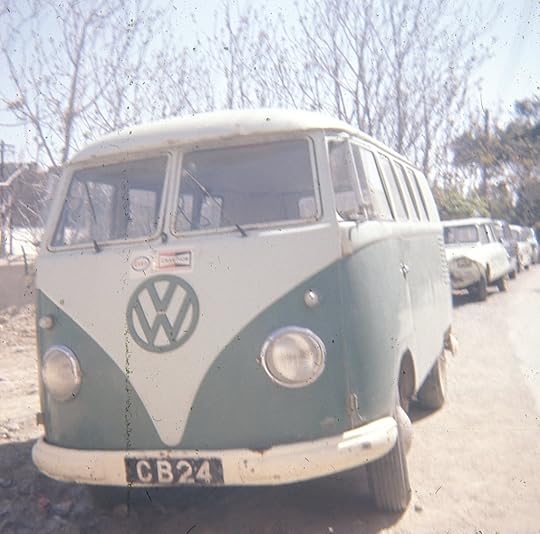
Like many people, I have fond childhood memories of VW vans, but I suspect mine are a little different than most. For about a year in the early 1970s, my family’s primary transportation was a shared, late-60s-model VW van known as the Penn Tank.
The name referred to the University of Pennsylvania logo on each side. The University’s archaeology department had lent it to the Kyrenia Ship Expedition, a group of American and British nautical archaeologists recovering and reconstructing a 2,300-year-old Greek merchant ship on the northern coast of Cyprus. It earned the “tank” moniker as a tribute to its predecessor, an older, more beleaguered VW van dubbed simply “The Tank” by one of the British members of the team.
I found myself thinking about the Tanks as I read Jill Lepore’s piece in the latest issue of The New Yorker about the new electric version of the VW van that Volkswagen plans to roll out in 2024. The story is largely an ode to the iconic vehicle that Arlo Guthrie referred to as a “microbus.” (VW had to be careful what it called the vehicle. See the part in the article about LBJ, the Chicken War and the resulting legislation that still affects import vehicles.)
I was too young to appreciate the counterculture applications of the VW van, but Lepore noted that in Europe the van “could do anything: it was used as a fire truck, an ambulance, a delivery vehicle, a taxi.” I smirked. It was also used to haul diving equipment for raising ancient shipwrecks.
My father first arrived in Cyprus in mid-1971 with the hope of reassembling some 6,000 pieces of the Kyrenia Ships ancient hull fragments that had been sitting on the sea floor for more than two millennia. He had only the vaguest ideas of how to approach the project. No one had ever attempted anything like it.
He was greeted by two members of the expedition driving the faded green-and-white Tank. It had a tiny rear window, and both panels of the split windshield, inexplicably, opened outward so you could drive with the windshield up, breeze and bugs blowing in your face. The Tank was already about 15 years old by then, and the back seats had been removed to make room for air tanks, regulators and other equipment used for diving on the wreck site. In honor of my dad’s arrival, the team found an upholstered chair and put it in the back for my father to sit in for the 30-minute ride to Kyrenia. The Tank broke down three times on the way back, the last time as it topped the Kyrenia Mountains. They coasted into town.
By comparison, the Penn Tank, which arrived a year or so later from a land dig — in Afghanistan? Iran? — was pure luxury. It was much newer — larger rear window and while the windshield was still split, it didn’t open. Because my father was the only member of the expedition with children, we were allowed to use the Penn Tank as our family car. It was an American vehicle, with the steering on the left. In Cyprus, as a former British colony, everyone drove on the left. Every trip was an adventure.
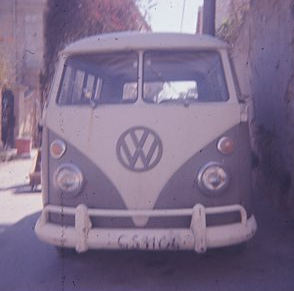 The Penn Tank
The Penn TankAnd while the Penn Tank was an upgrade from its predecessor, it was still a work vehicle, pressed into service in hauling diving gear, carpentry or welding supplies, anything that was needed. My mother recalled that she and my father had to drive it to a fancy dinner at the American embassy in Nicosia. She put a towel on the seat so she wouldn’t get her dress dirty, and they parked three blocks away, figuring the valet at the embassy would never believe they had an invitation.
The Kyrenia Ship was being preserved and rebuilt in a harbor side castle, most of which was built by Richard the Lionheart enroute to the Holy Land during the Third Crusade. After the last of the Kyrenia Ship’s hull fragments moved from fresh water to tanks of polyethylene glycol (the next step in the conservation process), we needed to demolish the large freshwater pool the wood had been soaking. My father would use the space to start reassembling the hull. But before we did, we decided to have a pool party. Everyone in the expedition donned bathing suits and piled into the Tanks with beach balls, rafts and brightly colored towels. We then drove in tandem across the narrow bridge and into the castle. Tourists gaped in confusion. It was the closest the expedition workhorses came to the sort of hippie moments that people statesside associate with the VW van.
Kyrenia was a small town, and we walked most places. But sometimes, my father would take the Penn Tank to the castle before we embarked on another errand. Parked in the courtyard, outside the “ship room,” I would pretend to drive, turning the massive steering wheel, fiddling with the turn signals, even once pulling it out of gear without using (or knowing about) the clutch. We covered a lot of ground my imagination, the Penn Tank and me, while waiting on my dad to tear himself away from his beloved ship.
The Penn Tank ultimately made its way to another dig in Turkey, and later, one of my father’s associates used it to flee Beirut with his family after civil war erupted in 1975. As for The Tank, it, too, found itself in a war zone. In the summer of 1974, my dad drove The Tank to the airport in Nicosia, then flew to Turkey for what should have been a weeklong trip. War erupted soon after he left. He wound up coming back to the U.S.
Another member of the expedition made his way back into Cyprus after the hostilities, and eventually to the airport in Nicosia. The airport had taken heavy shelling, and the parking lot was full of burned-out vehicles. Nestled among them, seemingly untouched, was The Tank. The tires are deflated, but with a few shots of air from a bicycle pump, The Tank once again putt-putted its way over the Kyrenia Mountains and back into town.
No one knows what happened to it after that. There are rumors it was spotted being driven around town, others say it was last seen near the harbor. I prefer to think of it atop the Kyrenia Mountains, lingering a moment before it begins to gather momentum and heads for the sea.
July 10, 2022
The promise and the podcast
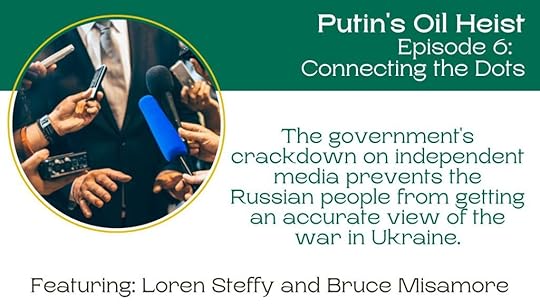
The final episode of Putin’s Oil Heist, my 6-part limited series podcast, is now out. It’s been a great run. The series chronicles the demise of the Russian oil company Yukos, told through the eyes of its former chief financial officer, Bruce Misamore. Bruce relates his experiences fleeing Russia and fighting to save the company to Russia’s invasion of Ukraine this year.
I had a lot of fun working with Bruce on the series, and I hope we get to dive even deeper into the story in the future. I’ve enjoyed the format of the narrated podcast, which is different from the radio-interview-style shows I’ve done before. It allowed for more storytelling, yet it still retained Bruce’s voice and perspective.
In the final episode, Bruce and I put the Yukos Affair in perspective and explore both the pain and the promise of the company’s history. Yukos was at the vanguard of a new business and economic environment that was emerging in Russia 20 years ago. Sadly, much of that was lost. Bruce shares other thoughts and insights about what’s happened in Russia since then, and why — including the role that state control of the media has played in keeping Putin in power.
While Bruce still thinks about what might have been, he’s also grateful for the opportunities Yukos afforded him, and he still relishes his time living in Russia.
To learn more, check out the whole series, or subscribe via your favorite podcast platform. And if your looking for other interesting podcasts — from sports to Enron to West Texas novel writing, you can find more here.
June 19, 2022
Father’s Day
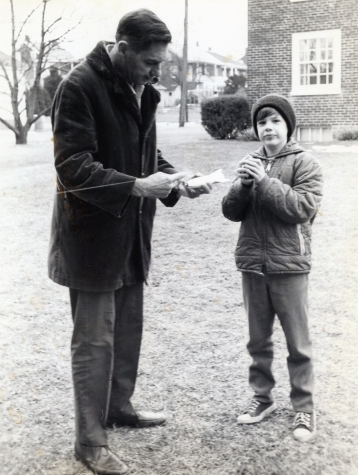 My father and me, testing a Cub Scout rubber-band rocket in about 1975.
My father and me, testing a Cub Scout rubber-band rocket in about 1975.My dad’s been gone for almost 15 years now, which seems hard to believe. This Father’s Day, I found myself thinking about him a lot, so I dug out this from Father’s Day 2013 and decided to re-post it.
Publisher’s Weekly just put out its list of the “10 Worst Dads in Books,” which seems like bad timing just before Father’s Day. While the article notes that “bad dads turn up less in fiction than bad moms,” the issue of bad fathers in books reminded me of some early discussions I had with publishers about The Man Who Thought Like a Ship.
I contacted a few commercial publishers, but they seemed disappointed that I hadn’t suffered any childhood angst, that my father hadn’t left me scarred somehow by showing greater love for his ships than his children.
Fortunately, the folks at Texas A&M Press knew my father well, and they understood. I approached my book as a journalist, but also as a son writing about his father. The fact that he was an inspiration was, I decided, part of the narrative. Soon after my father’s obituary appeared in the New York Times, a friend from Oregon emailed me and said “he sounds like the father the rest of us always wished we had.” I suppose that’s true.
A few months before he died, my father asked me out of the blue if I ever resented the fact the he was gone so much when I was growing up. I was shocked. We’d never talked about it, but even though he was often overseas for months at a time, I never felt abandoned. What I remembered was the hours he spent helping me on projects, taking me places, encouraging my interests and intellectual curiosity.
“I can’t think of anything that mattered to me that you weren’t there for,” I told him.
He looked surprised. “I missed your high school graduation,” he said. “Your mother never let me forget it.”
I thought about it for a moment and realized he was right. He’d gotten delayed overseas that year and hadn’t made it home in time. But I stood by my statement, and I still do.
After my father’s death in 2007, my brother and I knew lots of people would focus on his amazing accomplishments in nautical archaeology. In writing our eulogies, we wanted to focus on him as a father. Later, I tried to capture that in the book, too. Here’s what I wrote at the time:
Several years ago, after an INA board meeting, one of Dad’s students approached me and said she wanted to tell me how much Dad meant to his students and what a profound impact he’d had on their lives.
I remember thinking “yeah, he does that.” After all, if anyone can testify to the profound impact that Dad had on their lives, I can.
As many of you know, we spent a year on Cyprus when I was a kid – I was about seven at the time. That experience in and of itself was life changing – not many kids have a Crusader castle for a playground. But it was that time on Cyprus that awakened my interest in writing.
There weren’t a lot of books in English readily available for kids my age, and I was still young enough to command a bedtime story.
Often, the power would go off about the time I was getting ready for bed, and so between the lack of literature and the lack of lights, Dad began telling me stories from history. I learned about the Battle of Thermopolyae, the conquest of Alexander the Great, and, of course, Richard the Lionheart and the Third Crusade in our darkened living room.
But one night, Dad sat down at story time with some typewritten pages in his hand and began to read them to me. It was the tale of a pine tree – an Aleppo pine – that grew in a zig zag fashion. Because of this deformity, the other trees in the forest laughed at him. They were made into furniture and fine woodworking, but this tree, this Crooked Aleppo, was left behind.
One day a shipwright showed up in the forest and decided that the crooked tree would be perfect for the keel of a ship – a merchant ship as it were. The ship and its keel, crooked no more, sailed the Mediterranean for many years until one day it sank. Many more years went by until strange men with tanks on their backs uncovered the keel. They tried to raise him, and he broke into 16 pieces. They rebuilt him in a Crusader castle in a small town in northern Cyprus.
I think I caught on at the first mention of the word “keel,” but it didn’t matter. I was captivated. Every writer has some story, something they read in their youth, that they can point to as the spark that ignited their passion for words. For me, it was the story of Crooked Aleppo.
Not only was it a great story, but it was a story about something I knew and, more importantly, written by someone I knew. And written for me. It made me realize that stories didn’t just appear on shelves or in magazines, people wrote them. They wrote them for others. And I could write them too.
The summer we returned from Cyprus, I shamelessly copied my Dad’s format. I wrote an entire series about every piece of the Kyrenia ship – the frames, the maststep, the mast.
And from then on, I was always writing, always weaving stories.
It almost backfired, though. Years later, when I was a senior in high school, still driven by my passion for writing, I was dragging my feet about college. [Kids, you may now plug your ears.]
One night my dad came into my room and said we needed to talk seriously about college. I basically said I was thinking I’d just become a great and famous writer instead.
My dad, of course, didn’t get angry, didn’t raise his voice or even show any signs of disapproval. He paused for a moment, and then calmly said that he understood how I felt, but that I should realize making a living as a writer could be difficult and that it was a subjective business. And then he said: “I think you’re a good writer. But I’m your father, and I’m a little biased. So we have to realize there’s a chance you could stink. And if you stink, you’ll want something to fall back on.”
Even at 17, I couldn’t argue with that logic. Needless to say, I enrolled in A&M, found a career that combined my passion for words with the thirst for knowledge I inherited from my father and have spent the past 20 or so years trying very hard not to stink.
All of you who knew my dad as a friend, colleague, professor, mentor, brother, uncle or grandfather, were fortunate. But Dave and I were uniquely blessed because we knew him as a father.
At the time, it all seemed very normal, but I was reminded of how special it was just a few days ago when a friend in Oregon, having seen the stories on Dad’s death, said: “He sounds like the father the rest of us always wished we had.”
I’ve been a father myself now for about 16 ½ years, and every day I try to live up to the example he set. Every day, I come up short. His are shoes too big to fill.
Fortunately, my father also taught me perseverance, determination and that important achievements come through persistence.
Dad showed us the importance of chasing dreams. In fact, his life could be a practical guide to chasing dreams. He took risks, he gambled, but his gambles were rooted in practical sensibility and his victories were muted with humility.
As he allowed us to share in this great adventure that was his life, he never forgot the importance of simple pleasures like bedtime stories.
And in pursuing his own dream, he managed to ignite the dreams of others.
Maybe there are a lot of bad dads in books. I’m grateful to tell the story of a good one. Happy Father’s Day.



